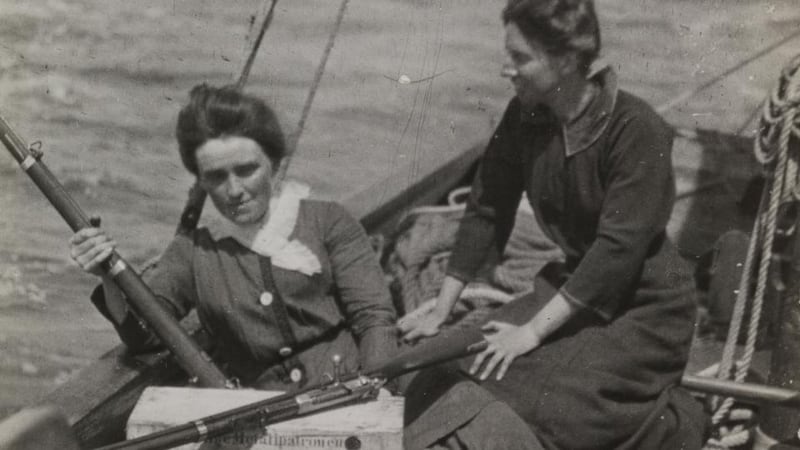A week after the Howth gun-running of July 26th, 1914, there occurred the equally audacious gun-running at Kilcoole in Co Wicklow – the other half, as it were, of the same mission to obtain arms for the Irish Volunteers.
Around midnight on August 1st, 1914, 600 German-made Mauser 71 single-shot rifles, together with 20,000 rounds of ammunition, were landed on the beach of the small north Wicklow seaside town and spirited away under cover of darkness. They were part of the single, original consignment, from which 900 Mausers and 29,000 bullets were landed at Howth a week earlier.
History has overshadowed the Kilcoole operation in preference to what occurred at Howth and while that event will be commemorated next weekend, heritage enthusiasts and local historians in Kilcoole will also be marking their area’s role in the gun-running.


One of the remarkable aspects of the entire gun-running exercise is the role played by Protestants. The key instigator, prompted in large measure by the April 1914 Larne gun-running by the Ulster Volunteers, was Roger Casement, a member of the British establishment, born in Ireland of a mixed marriage, baptised a Catholic but raised a Protestant.
The plot was hatched at a meeting in the Grosvenor Road, London, home of Alice Stopford Green, the 66-year-old daughter of the Church of Ireland Archdeacon of Meath, granddaughter of a Church of Ireland bishop of Meath and widow of the English historian, John Richard Green.
Other key players at that meeting included Darrell Figgis, an Achill-based writer and Sinn Féin activist who was also Protestant; and Mary Ellen Spring Rice, daughter of Thomas Spring Rice, second Baron of Monteagle, with estates in Kerry and Limerick, and cousin of the British ambassador to the US. Despite her Anglo-Irish aristocratic and Protestant background, Mary Ellen was a nationalist and a protégé of her co-religionist, Douglas Hyde.
The owners of the two yachts that would bring the guns to the Irish coast, the Asgard and the Kelpie, respectively Erskine Childers, assisted by his wife Molly, and Mary Spring Rice's cousin, Conor O'Brien, were both also of Protestant stock.
It was agreed at the London meeting that Stopford Green would donate half the money to buy the guns and get them transported from Germany to Ireland. Mary Spring Rice and Darrell Figgis would raise the rest of the cash, while Figgis and Casement would use their contacts in Germany to effect the purchase.
Best-laid plans
The plot was simple enough. Once bought from the Hamburg-based arms dealer Moritz Magnus der Jungere, (who also supplied the anti-home rule UVF), the guns and ammunition would be taken by rail to Hamburg from their storage warehouse in Liège and from there, by the tugboat Gladiator southwest through the North Sea, to the Ruytingen Lightship, moored in the English Channel on a sandbank close to the mouth of the river Scheldt and the French port of Dunkirk.
At that point, Gladiator, with Figgis on board, was met by the Asgard, captained by Childers, and Kelpie, captained by O'Brien, and the cargo was split between the two yachts – 900 guns and 29,000 bullets being offloaded onto the Asgard, and the remaining 600 guns and 20,000 bullets onto the Kelpie.
When the guns were landed at Howth, they were removed from the Asgard by Volunteers under the command of Bulmer Hobson (a Quaker – at least until his role emerged and he felt obliged to resign, in deference to his Friends' disavowal of violence).
The Kilcoole guns would never have reached their destination had it not been for the role of another Protestant, Sir Thomas Myles, president of the Royal College of Surgeons in Ireland and, as of November 1914.
He was a temporary Lieutenant-Colonel in the Royal Army Medical Corps and Honorary Surgeon in Ireland to the King – two positions from which he would doubtless have been excluded had the British known that he had just lent his yacht, the Chotah, to effect the Kilcoole gun-running.
It was borrowed at the request of yet another Protestant conspirator, James Creed Meredith, later a member of the Supreme Court of the Irish Free State he helped create.
The Chotah met the Kelpie off the Llyn Peninsula of north-central Wales and the Kelpie's cargo was offloaded onto the larger yacht, allowing the Kelpie to sail on across the Irish Sea, providing a decoy for the Asgard against the prying eyes of the Coast Guard.
Offloading the arms
A week after the guns were landed at Howth, the Chotah approached the coast of Kilcoole and was met in darkness, south of the Kish lighthouse by the Nugget, a Howth-based trawler. The Nugget towed the yacht close to the Kilcoole shore, near today's train station, and a flotilla of smaller vessels went out to collect the guns.
From the beach, the arms were loaded by Volunteers and their supporters onto vehicles and bicycles, and also, according to local folklore, into babies’ prams, and taken away hurriedly.
One of the vehicles involved, a charabanc (an elongated, open-top car capable of carrying about 20 passengers, essentially an early version of a bus) broke down in Little Bray. After initially hiding the charabanc’s cargo in various adjacent back yards, the guns and ammunition were eventually moved to St Enda’s, Pádraig Pearse’s school in Rathfarnham.
The rest, as they say, is history. . .
On Thursday next at 8pm, Dr Ruan O’Donnell of the University of Limerick will deliver a centenary lecture in Kilcoole Golf Club on the Kilcoole gun-running. On Saturday 26th and Sunday 27th, the village will host its Centenary Heritage Festival involving re-enactments, a parade, exhibitions, displays of traditional crafts and music. Full programme at bray.ie/kilcoole-1914-centenary/










